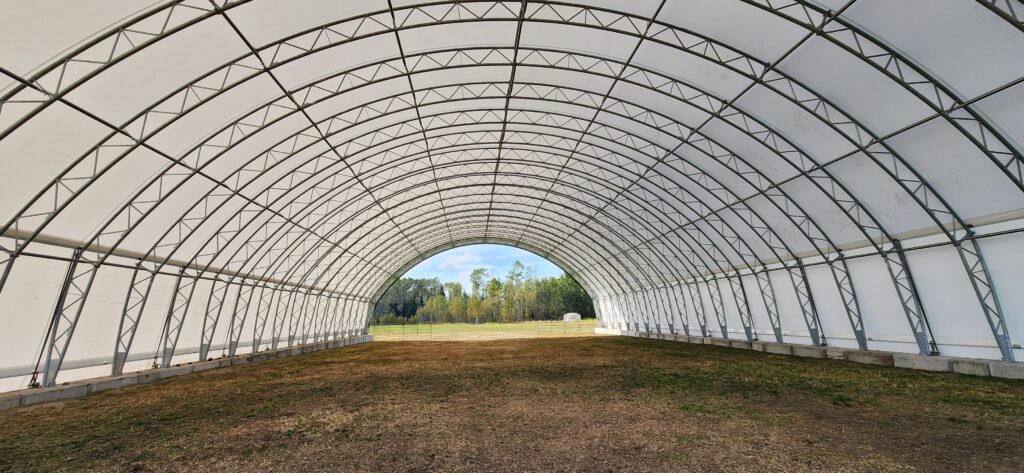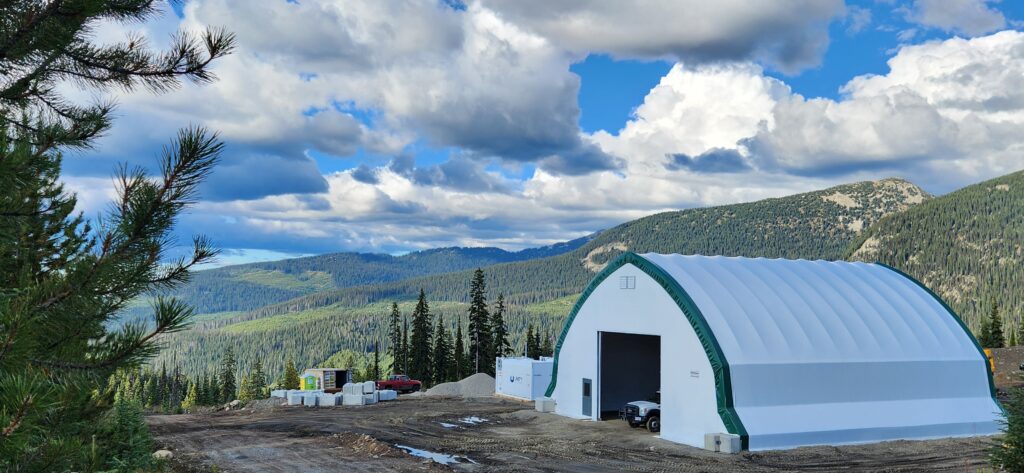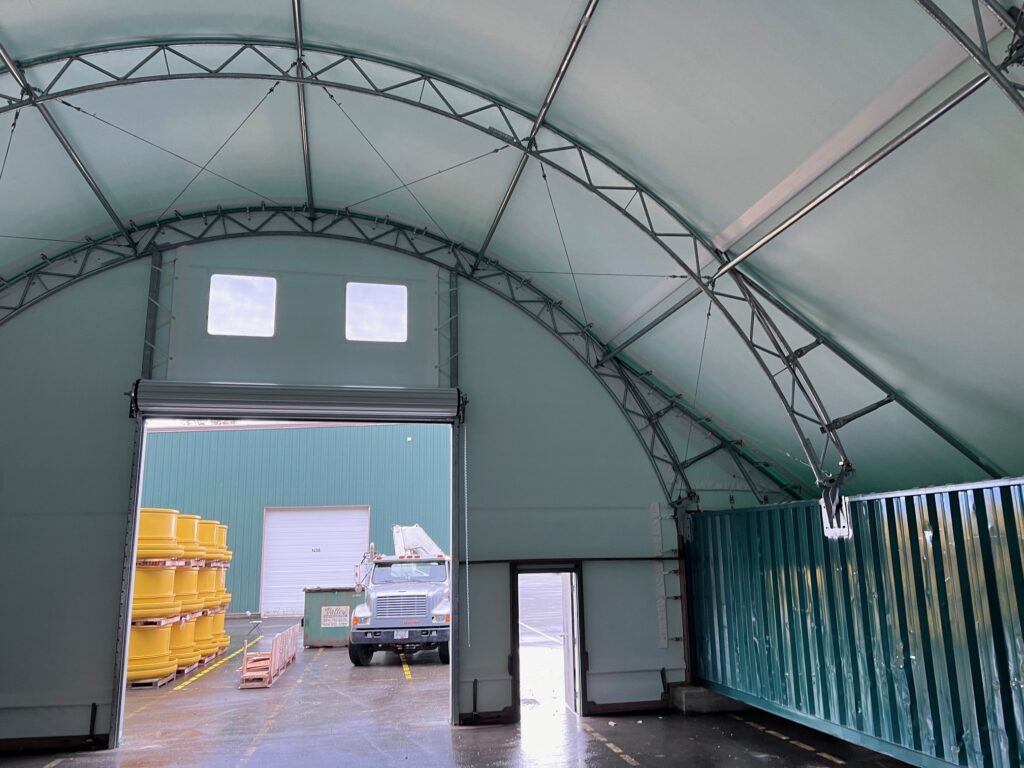Which Buildings Are Ideal for Agricultural Storage in Canada?
Canada’s agricultural industry plays a huge role in our economy, supporting rural livelihoods, ensuring food supply, and fueling international trade. Whether you run a dairy farm in Ontario, grow crops across the Prairies, or raise livestock out in British Columbia, having the right kind of storage is key to keeping things running smoothly.
Reliable storage keeps your equipment, grain, feed, and animals safe from Canada’s unpredictable weather, and it also helps your day-to-day operations stay on track. But with so many building options out there, how do you pick the one that’s right for your farm?
In this guide, we’ll look at the most popular farm building types for agricultural storage, break down their pros and cons based on materials and design, and share examples from real Canadian farms. Whether you’re building from the ground up or upgrading an old structure, this will help you choose wisely.
Why Smart Storage Is More Important Than Ever
With growing pressure on food systems, sustainability goals, and efficiency on the farm, having the right infrastructure isn’t just a bonus; it’s essential. Whether you’re adding a farm storage unit or building a full-size farm barn, your structure affects:
- How long your products last.
- How efficient your team is.
- How well your machines are protected.
- Animal health and biosecurity.
Add to that Canada’s tough winters and unpredictable weather, and it’s easy to see why choosing the right farm building is a big deal.
Check out Spanmaster’s building solutions for agriculture, designed for all-weather performance.
What to Think About When Choosing a Farm Storage Building
Not all farm storage structures are built the same. Before you make a decision, ask yourself:
- What will you use it for: livestock, feed, equipment, or all of the above?
- Will your storage needs grow in five or ten years?
- Can the building handle heavy snow, moisture, and temperature swings?
- How fast can you get it built and ready?
- What will it cost upfront, and what will be the ongoing maintenance costs?
From simple machine sheds to multifunctional barns, the building you choose can either support or slow down your daily operations.
Check out our guide on how to install fabric buildings: quick, easy, and cost-effective.
Top Building Types for Farm Storage in Canada
1. Fabric-Covered Buildings
These are one of the most versatile and budget-friendly options available today. They let in natural light, go up quickly, and are easy to scale or move.
Great for: Hay, grain, large equipment, and bulk storage.
Why Farmers Love Them:
- Good airflow and UV protection help control moisture
- Lower cost than steel or wood-frame options
- Easy to expand or relocate
You’ll often see these in the Prairies, where grain operations demand lots of adaptable space.
Check out Spanmaster’s custom commercial building options.
2. Steel-Framed Buildings
If you’re looking for something that’ll stand the test of time and tough weather, steel is hard to beat.
Perfect for: Cold storage, expensive gear, or all-purpose sheds.
Key Benefits:
- Fire-resistant and pest-proof
- Low maintenance
- Supports insulation and HVAC (heating, ventilation, and air conditioning)
These buildings are especially popular in Ontario and Quebec, where frigid winters can freeze operations if you’re not properly equipped.
Need industrial-level storage? Spanmaster’s got options for industrial buildings, too.
3. Pole Barns and Traditional Barn Styles
Modern pole barns have come a long way from the old red barns of the past. These days, they can be customized with wood and steel elements and used for everything from animal care to storage.
Ideal for: Housing livestock, milking parlours, or mixed-use farms.
What Makes Them Stand Out:
- Great natural ventilation and wide open interiors
- Budget-friendly with a classic farm look
- Ideal for small farms or backup storage
If you’re looking for a proven structure that covers all bases, pole barns are a solid bet.
Arch vs. Peak: Which Shape Suits Your Farm?
1. Arch-Style Buildings
With their curved design, arch-shaped buildings are great at shedding snow, making them a smart choice in winter-heavy regions. Plus, no interior beams mean more usable space.
Advantages:
- Excellent for storing tall gear or bulk materials
- Withstands snow and wind like a champ
- Efficient design makes them cost-effective
2. Peak-Style Buildings
The peak-shaped buildings offer a more traditional appearance, with lots of headroom and flexible interior layouts, especially useful if you’re using racking or shelving systems.
Why Choose These:
- Great for organized storage or workshops
- Can be insulated for year-round use
- Fits right in with typical farm architecture
3. Real-Life Examples of Storage Facilities in Agriculture
Here’s how some Canadian farmers have used building solutions that suit their specific needs:
- In Eastern Ontario, a dairy farm built a steel structure with both cold storage and a livestock area in one efficient space.
- A mixed-use farm in Nova Scotia added a hybrid pole barn for hay, tools, and machinery, cutting down time spent moving between buildings.
Both of these farms made smart choices based on their size, location, and growth plans.
4. Planning a Farm Construction? Don’t Skip These Essentials
A successful construction farm build takes more than materials. You’ll also need to think ahead.
Make sure to consider:
- Local zoning rules and permit requirements
- Drainage and airflow for moisture control
- A solid foundation and anchoring
- Roofing and siding that match your use case
Our experienced team can walk you through these steps, ensuring everything’s up to code and built to last.
5. Multi-Use Potential Beyond Agriculture
Many agricultural storage buildings also double as storage for personal or municipal use. From boats and RVs (recreational vehicles) to snowplows and salt spreaders, personal storage offers more value than you might expect.
6. Choosing the Right Partner
Farm construction isn’t like building in the city; you need a partner who understands agriculture and rural challenges. At Spanmaster, we blend engineering smarts with hands-on farming knowledge to create structures that grow with your operation.
Why work with us?
- Custom designs tailored for your land and needs
- CSA-A660 certified for Canadian conditions
- Full-service support from concept to completion
Choosing the right storage building is one of the smartest investments you can make. From classic barns to modern, climate-ready options, there’s a structure that fits your needs and your future.
Step-by-Step Guide to Installing a Fabric Building
The popularity of tension fabric structures known as fabric buildings continues to rise in Canada because they offer flexibility, affordable prices, and fast deployment capabilities. The installation process for fabric buildings requires proper understanding because it determines both durability and functionality for agricultural storage and commercial and personal uses.
The following guide provides a detailed overview of tension fabric building installation procedures, together with essential best practices to help you complete a successful setup.
Understanding Tension Fabric Buildings
A sturdy frame, usually composed of steel or aluminum, is encased in a long-lasting fabric membrane to form a tension fabric building. To create a sturdy and weatherproof structure, the fabric is tensioned over the frame. These structures are renowned for their ease of assembly, versatility, and suitability for a range of uses, such as industrial storage, personal use, and agriculture.

Important advantages include:
- Cost-Effectiveness: Less expensive to build and maintain than conventional structures.
- Flexibility: Designs that can be altered to suit particular requirements.
- Durability: Able to withstand severe weather.
- Natural Lighting: By letting in natural light, translucent fabric lowers energy expenses.
Read our article on the future of fabric and steel structures to learn more about the benefits and upcoming advancements of these structures.
Pre-Installation Considerations
The fabric building installation requires several preparatory steps that need to be addressed before starting work.
- Site Assessment: The evaluation of the planned site must include assessments for soil stability, drainage, and accessibility. Check that your project meets all local zoning requirements before starting work and secure required authorization.
- Design Selection: Choose your preferred design between arch-shaped buildings and peak-shaped buildings according to your needs and visual preferences.
- Foundation Planning: The foundation selection process requires determination of concrete footings, ground anchors, or alternative systems based on soil conditions and intended building purpose.
- Climate Considerations: The structural integrity needs assessment should include local weather pattern analysis for snow loads and wind speeds.

Tools and Materials Required
A successful fabric building installation necessitates specific tools and materials:
Materials:
- Galvanized steel or aluminum frame components
- High-tensile fabric membrane (PVC or polyethylene)
- Anchoring systems (e.g., ground anchors, concrete footings)
Tools:
- Cranes or lifts for hoisting materials
- Hand tools (wrenches, hammers, etc.)
- Tensioning devices (ratchets, come-alongs)
- Safety equipment (helmets, harnesses, gloves)
All equipment needs to be in proper working condition while operated by trained personnel to uphold safety standards.
Step-by-Step Fabric Building Installation Process
Here’s a step-by-step guide on how to install a fabric building.
1. Site Preparation
Start by removing all debris, vegetation, and any other obstructions from the site. Level the ground and mark the layout according to the building’s specifications. The stability and longevity of the structure depend on proper site preparation.
2. Foundation Installation
The selected foundation system requires installation that must match both the building design and local building regulations. The foundation needs precise placement, together with secure anchoring systems, to resist environmental stresses.
3. Frame Assembly
The structural frame requires assembly through manufacturer-approved connections of steel or aluminum components. The placement of large sections requires crane or lift equipment for safe positioning. All connections must be checked for proper security and correct alignment.

4. Fabric Installation
Place the fabric membrane over the completed frame after unrolling it. The fabric needs to be stretched evenly using tensioning devices to achieve a tight fit while removing wrinkles. The building strength and appearance improve when tensioning is done correctly.
5. Final Adjustments and Inspection
A complete inspection should verify that all components are properly installed and tensioned. The structure should be checked for any indications of stress or misalignment. The structure requires adjustments to maintain both its performance and integrity.
Tailored Building Solutions by Industry
Each industry requires unique structural needs, environmental requirements, and operational workflows for tension fabric buildings to serve their purpose. The following section explains how fabric building installation adjusts according to different industry requirements:
Agricultural Applications
The agricultural sector needs dependable, weather-resistant structures at affordable costs to shelter livestock and equipment, as well as feed supplies. The tension fabric structure design offers superior ventilation, natural lighting, and extensive open space that makes it ideal for barns and hay storage facilities and machinery shelters. Our building solutions for agriculture provide complete weather resistance and farm operational support for Canadian farms.
Commercial Use Cases
The fabric building market serves retailers, logistics companies, and event organizers who need temporary or semi-permanent spaces for inventory storage, showrooms, and seasonal operations. The buildings enable business flexibility through fast installation and branding options that support both business agility and growth. Our commercial buildings provide space solutions through efficient and quick deployment methods to support business expansion.
Industrial Applications
Industrial businesses, including mining, oil and gas, and manufacturing, benefit from tension fabric structures because they deploy quickly and scale up easily while meeting all necessary safety standards. The buildings function as equipment storage facilities and workshops and provide warehousing capacity. Our industrial buildings deliver customized high-performance solutions that meet the requirements of heavy-duty operations.
Your fabric building installation should match your industry requirements to achieve both immediate operational efficiency and extended product longevity.
Post-Installation Maintenance and Inspection
The longevity and functionality of tension fabric buildings depend on regular maintenance practices.
- Routine Inspections: The fabric should be inspected regularly for tears while checking the frame for corrosion and verifying the stability of anchoring systems.
- Cleaning: Any dirt and debris should be removed from the fabric surface to prevent degradation.
- Tension Adjustments: The fabric needs periodic re-tensioning because it will naturally lose its structural integrity over time.
- Component Replacement: The building’s safety depends on the immediate replacement of all worn or damaged parts.
Importance of Professional Installation
Professional installation provides multiple benefits to customers who choose this approach instead of doing it themselves.
- Expertise: The knowledge and experience of professionals enable them to complete complex installations with maximum efficiency.
- Compliance: The installation process follows all local building codes and safety regulations.
- Warranty Protection: Professional installation is often necessary for manufacturers to honour their warranty coverage.
- Time and Cost Efficiency: Professional installation services minimize the chance of mistakes that otherwise would require expensive repairs or cause project delays.
Professional services provide both peace of mind and long-term financial savings to customers.
The installation process of fabric buildings requires multiple steps that, when properly followed, lead to durable structures that serve multiple purposes. A successful project outcome depends on your understanding of site preparation through post-installation maintenance steps.
Our team is available to provide personalized solutions and expert guidance for your project requirements while discussing municipal solutions and personal storage options.
The Future of Fabric and Steel Structures: Trends and Innovations in 2025
The construction world is being reshaped by fabric and steel structures. These aren’t just strong and long-lasting; they’re flexible, green, and totally game-changing. Industries are evolving, profits are increasing, and the built environment is becoming far more environmentally conscious. Let’s peek at the exciting developments headed our way in 2025 and beyond.
Fabric Buildings: Advancements in Design and Materials
Fabric structures: think chic, lightweight, and super versatile. They’re morphing into sophisticated design solutions. Imagine a material that can adapt to almost any need, looking good and working hard at the same time.
Innovation is the engine of fabric tech. Picture materials tough enough to handle extreme weather, UV resistant, and even self-cleaning! The push toward sustainability is also driving innovation in building fabric. Green fabrics made from recycled materials or biodegradable polymers are now becoming available, allowing for more environmentally friendly construction solutions. These innovations are paving the way for eco-friendly designs that can be incorporated into various sectors, from building solutions for agriculture to municipal solutions.
As a result fabric structures are popping up everywhere:
- Sports: Picture a translucent stadium roof, letting the light in.
- Agriculture: Affordable, climate-controlled environments for growing food and raising livestock.
- Industrial Solutions: Fabric can be a nice choice for numerous industrial buildings.
- Aviation: Imagine lightweight, relocatable aircraft hangers that go where you need them.
- Public Spaces: Eye-catching and practical gathering spots like amphitheaters and event hubs.
- Personal Storage: Fabric buildings will continue to dominate in areas like personal storage with added capabilities in energy efficiency and cost reduction.
Big picture? Sustainability. A relentless focus on renewables and environmentally sound practices is the future of fabric construction. The versatility of fabric, combined with its ability to cover vast open spaces, also means that arch shape buildings and peak shape buildings are set to become more prominent. These styles not only provide functional space but also add an aesthetic value to commercial and industrial projects.
Steel Structures: The Rise of Customization and Efficiency
Steel: it’s still a king, thanks to unmatched strength that also endures. But even this material is evolving!
Tech advancements are transforming steel fabrication and design. Think about intricate components, 3D-printed with incredible precision. Or entire building sections, prefabricated for lightning-fast assembly. This is becoming the new normal.
One of the most exciting innovations in the future of steel structures is the increasing level of customization. With advances in future steels and more sophisticated fabrication techniques, steel buildings can now be tailored to meet the specific needs of any project. Whether it’s for industrial buildings, commercial buildings, or even municipal solutions, steel is becoming more adaptable to a wide range of design demands.
And what about energy efficiency? Better insulation, smarter coatings, high-tech systems… all turning steel buildings into energy-saving champions, cutting costs and environmental damage.
Integration of Fabric and Steel: Hybrid Solutions for the Future
Why choose? Mix and match! The combination creates some seriously innovative hybrid structures. Think sturdy steel frames, elegantly draped in flexible fabric.
Hybrid structures strike the perfect balance: budget-friendly, adaptable design, rock-solid durability. You get steel’s muscle and fabric’s flexible, eye-catching appeal.
Some real-world examples:
- Sports Stadiums: Retractable fabric roofs, ready to roll, supported by steel backbone.
- Event Spaces: Open-air venues that have soaring fabric canopies anchored by steel for the event to take place.
- Emergency Shelters: Shelters are rapidly deployable by combining steel frames with tough, weatherproof fabric.
Sustainability in Fabric and Steel Structures
Bottom line: sustainability matters. The construction world has to shrink its environmental footprint and that’s why the future of fabric structures is bright.
Sustainable practices are taking center stage in fabric and steel construction. Key examples include:
- Better ways to recycle steel and fabric.
- Smaller carbon footprints thanks to smarter material choices.
- Sourcing renewable energy to power it all.
Fabric and steel are vital to crafting eco-friendly, energy-efficient buildings that cut down on resource waste and environmental impact.
Future Market Outlook and Opportunities
The experts foresee ongoing growth by 2025, emphasizing sustainable, innovative building methods. There are fresh opportunities for businesses to get involved to develop. Fabric and steel offer a ton of exciting projects, and innovative materials. Think embracing these innovations will give builders a serious edge to be competitive!
Hold on tight – future tech is here! Smart materials about to shake up fabric and steel structures. Envision self-healing materials that fix themselves, fabrics that react to sunlight, and coatings that change color with temperature.
Automation and robotics: rising stars. Automated manufacturing churning out precise steel components, AI-powered design, robots swiftly installing fabric. It’s all happening. Basically, construction is being revolutionized. Faster, greener, more efficient.
Fabric and steel structures are evolving at breakneck speed. Construction’s looking brighter and greener for material breakthroughs is smart-tech integration. These developments present unique opportunities for forward-thinking enterprises.